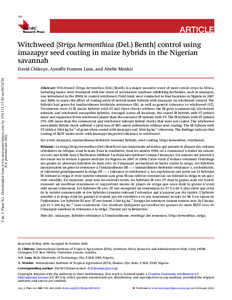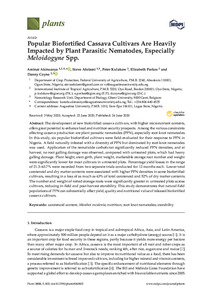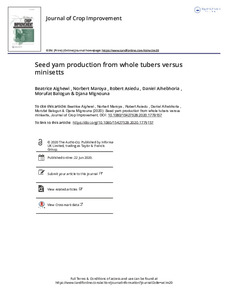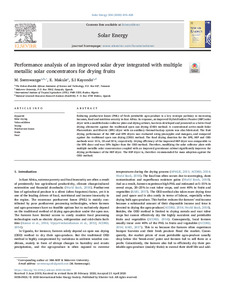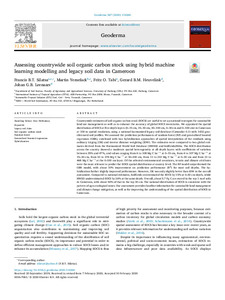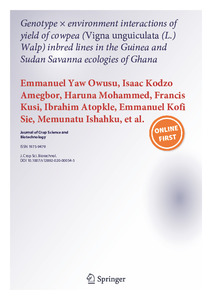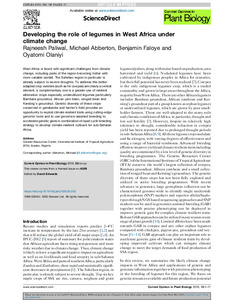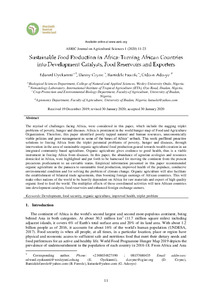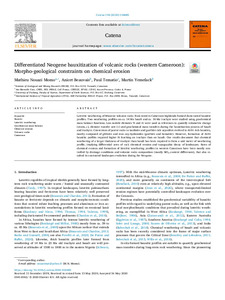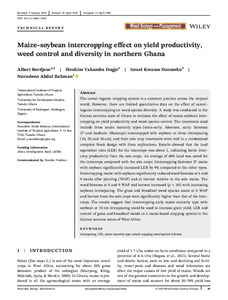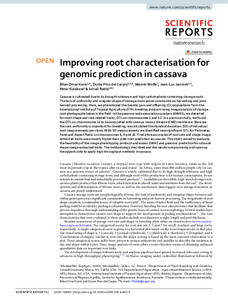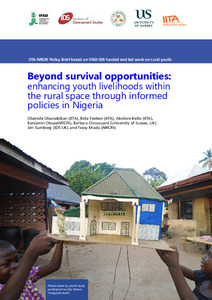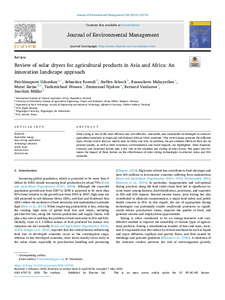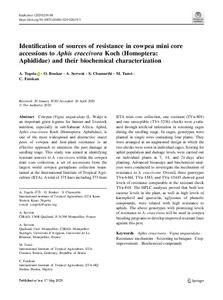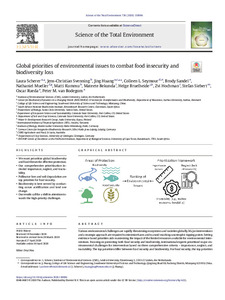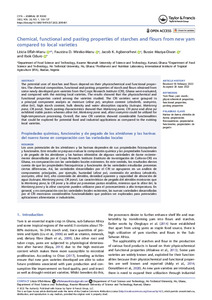Welcome to the International Institute of Tropical Agriculture Research Repository
IITA Bibliography System: Recent submissions
Now showing items 1001-1020 of 8102
-
Witchweed [Striga hermonthica (Del.) Benth] control using imazapyr seed coating in maize hybrids in the Nigerian savannah
(2020-08)Witchweed [Striga hermonthica (Del.) Benth] is a major parasitic weed of most cereal crops in Africa, including maize. Seed treatment with low doses of acetolactate synthase–inhibiting herbicides, such as imazapyr, was introduced in the 1990s to control witchweed. Field trials were conducted in four locations in Nigeria in 2007 and 2008, to assess the effect of coating seeds of several maize hybrids with imazapyr on witchweed control. The hybrids had genes for imidazolinone herbicide resistance ... -
Popular biofortified cassava cultivars are heavily impacted by plant parasitic nematodes, especially Meloidogyne Spp.
(2020)The development of new biofortified cassava cultivars, with higher micronutrient contents, offers great potential to enhance food and nutrition security prospects. Among the various constraints affecting cassava production are plant parasitic nematodes (PPN), especially root-knot nematodes. In this study, six popular biofortified cultivars were field-evaluated for their response to PPN in Nigeria. A field naturally infested with a diversity of PPN but dominated by root-knot nematodes was used. ... -
Seed yam production from whole tubers versus minisetts
(2020)Yam (Dioscorea rotundata Poir.) is a major staple and cash crop for millions of households in West Africa, where about 93% of the world crop is produced. The tuber serves as food and seed. Depending on the size, seed tubers are often cut into setts, minisetts, or planted whole. An experiment was conducted to investigate the effects of using whole tubers versus minisetts to produce seed yams. Six treatments constituted combinations of whole tubers and minisetts, and three tuber-size classes, viz., ... -
Making smallholder value chain partnerships inclusive: exploring digital farm monitoring through farmer friendly smartphone platforms
(2020)Value chain partnerships face difficulties achieving inclusive relations, often leading to unsustainable collaboration. Improving information flow between actors has been argued to contribute positively to a sense of inclusion in such partnership arrangements. Smallholders however usually lack the capability to use advanced communication technologies such as smartphones which offer a means for elaborate forms of information exchange. This study explores to what extent co-designing smartphone ... -
Field efficacy of two atoxigenic biocontrol products for mitigation of aflatoxin contamination in maize and groundnut in Ghana
(2020-11)Biological control is one of the recommended methods for aflatoxin mitigation. Biocontrol products must be developed, and their efficacy demonstrated before widespread use. Efficacy of two aflatoxin biocontrol products, Aflasafe GH01 and Aflasafe GH02, were evaluated in 800 maize and groundnut farmers’ fields during 2015 and 2016 in the Ashanti, Brong Ahafo, Northern, Upper East, and Upper West regions of Ghana. Both products were developed after an extensive examination of fungi associated with ... -
CRISPR/Cas9-based genome editing of banana for disease resistance
(2020-08)Banana production is severely constrained by many pathogens and pests, particularly where a number of them are co-existing. The use of disease-resistant banana varieties is one of the most effective ways to mitigate the negative impacts of pathogens on banana production. Recent advances in new breeding techniques have the potential to accelerate breeding of banana for disease resistance. The CRISPR/Cas9 based genome editing has emerged as the most powerful tool for crop improvement due to its ... -
Performance analysis of an improved solar dryer integrated with multiple metallic solar concentrators for drying fruits
(2020-07-01)Reducing postharvest losses (PHL) of fresh perishable agro-produce is a key strategic pathway to increasing incomes, food and nutrition security in East Africa. In response, an improved Hybrid Indirect Passive (HIP) solar dryer with a modified solar collector plate and drying cabinet, has been developed and presented as a better food drying alternative against the traditional open sun drying (OSD) method. A conventional active-mode Solar Photovoltaic and Electric (SPE) dryer with an auxiliary ... -
Assessing countrywide soil organic carbon stock using hybrid machine learning modelling and legacy soil data in Cameroon
(2020-05-15)Countrywide estimates of soil organic carbon stock (SOCS) are useful to set up national strategies for sustainable land use management as well as to enhance the accuracy of global SOCS inventories. We appraised the spatial distribution of SOCS at five depth layers (0–15 cm, 15–30 cm, 30–100 cm, 0–30 cm and 0–100 cm) in Cameroon at 100 m spatial resolution, using a national harmonized legacy soil database (Camsodat 0.1) with 1432 georeferenced soil profiles. We assessed the prediction performances ... -
Genotype x environment interactions of yield of cowpea (Vigna unguiculata (L.) Walp) inbred lines in the Guinea and Sudan Savanna ecologies of Ghana
(2020-06-08)The variable cowpea productivity across different environments demands evaluating the performance of genotypes in a breeding program prior to their release. The aim of this study was to assess yield stability of eight cowpea advanced breeding lines selected from participatory varietal selection in multilocational trials, and to identify mega-environments for cowpea production in Ghana. The genotypes were evaluated across five environments in 2016 and 2017 in randomized complete block design with ... -
Developing the role of legumes in west Africa under climate change
(2020-08)West Africa is faced with significant challenges from climate change, including parts of the region becoming hotter with more variable rainfall. The Sahelian region in particular is already subject to severe droughts. To address this better adapted crop varieties (such as for cowpea) are clearly a central element, a complementary one is a greater use of resilient alternative crops especially underutilized legumes particularly Bambara groundnut, African yam bean, winged bean and Kersting’s groundnut. ... -
Sustainable food production in Africa: turning African Countries into development catalysts, food reservoirs and exporters
(2020)The myriad of challenges facing Africa, were considered in this paper, which include the nagging triplet problems of poverty, hunger and diseases. Africa is prominent in the world hunger map of Food and Agriculture Organization. Therefore, this paper identified poorly tapped natural and human resources, uneconomically viable policies and poor management as some of the banes of Africa’ setback. This work proffered proactive solutions to freeing Africa from the triplet perennial problems of poverty, ... -
Differentiated Neogene bauxitization of volcanic rocks (western Cameroon): morpho-geological constraints on chemical erosion
(2020-11)Lateritic weathering of Miocene volcanic rocks from western Cameroon highlands formed duricrusted bauxitic profiles. Two weathering profiles on ca. 14 Ma basalt and ca. 16 Ma trachyte were studied using geochemical mass balance functions. Less mobile elements Ti and Zr were used as references to quantify volumetric change (strain, ε), element transfer rate (τ) and geochemical mass transfers during the bauxitization process of basalt and trachyte. Conversion of parent rocks to kaolinite and goethite ... -
Maize–soybean intercropping effect on yield productivity, weed control and diversity in northern Ghana
(2020-06-29)The cereal–legume cropping system is a common practice across the tropical world. However, there are limited quantitative data on the effect of cereal–legume intercropping on weed species diversity. A study was conducted in the Guinea savanna zone of Ghana to evaluate the effect of maize–soybean intercropping on yield productivity and weed species control. The treatments used include three maize maturity types (extra‐early: Abontem, early: Sammaz 27 and medium: Obatanpa) intercropped with soybean ... -
Improving root characterisation for genomic prediction in cassava
(2020-05-14)Cassava is cultivated due to its drought tolerance and high carbohydrate-containing storage roots. The lack of uniformity and irregular shape of storage roots poses constraints on harvesting and post-harvest processing. Here, we phenotyped the Genetic gain and offspring (C1) populations from the International Institute of Tropical Agriculture (IITA) breeding program using image analysis of storage root photographs taken in the field. In the genome-wide association analysis (GWAS), we detected for ... -
Impacts of CGIAR maize improvement in sub-Saharan Africa 1995-2015
(International Maize and Wheat Improvement Center, 2021-03) -
Review of solar dryers for agricultural products in Asia and Africa: an innovation landscape approach
(2020-08-15)Solar drying is one of the most efficient and cost-effective, renewable, and sustainable technologies to conserve agricultural products in Asian and sub-Saharan African (SSA) countries. This review paper presents the different types of solar dryers that are widely used in Africa and Asia. In addition, the pre-eminent effects of their use on product quality, as well as their economic, environmental, and social impacts, are highlighted. Since financial, external, and structural factors play a key ... -
Identification of sources of resistance in cowpea mini core accessions to Aphis craccivora Koch (Homoptera: Aphididae) and their biochemical characterization
(2020-05-17)Cowpea (Vigna unguiculata (L. Walp) is an important grain legume for human and livestock nutrition, especially in sub-Saharan Africa. Aphid, Aphis craccivora Koch (Homoptera: Aphididae), is one of the most widespread and destructive insect pests of cowpea and host-plant resistance is an effective approach to minimize the pest damage at seedling stage. This study was aimed at identifying resistant sources to A. craccivora within the cowpea mini core collection, a set of accessions from the largest ... -
Global priorities of environmental issues to combat food insecurity and biodiversity loss
(2020-08-15)Various environmental challenges are rapidly threatening ecosystems and societies globally. Major interventions and a strategic approach are required to minimize harm and to avoid reaching catastrophic tipping points. Setting evidence-based priorities aids maximizing the impact of the limited resources available for environmental interventions. Focusing on protecting both food security and biodiversity, international experts prioritized major environmental challenges for intervention based on three ... -
Chemical, functional and pasting properties of starches and flours from new yam compared to local varieties
(2022)The potential uses of starches and flours depend on their physicochemical and functional properties. The chemical composition, functional and pasting properties of starch and flours obtained from some newly developed yam varieties from the Crops Research Institute (CRI), Ghana were evaluated, and compared with the existing local varieties. The results showed that the physicochemical and functional properties varied among the varieties studied. The CRI varieties were grouped in a principal component ...

